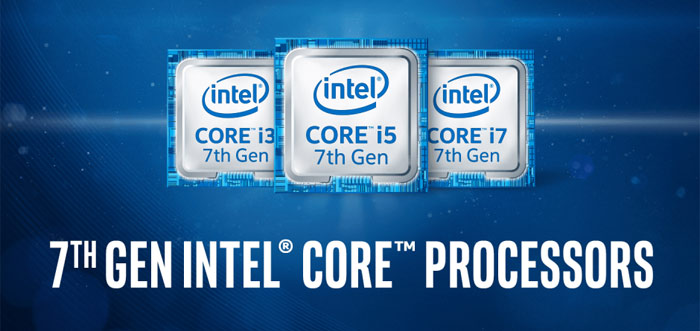Breaking News
Main Menu
I3 7th Generation Processor
пятница 03 апреля admin 22
Intel® Celeron® 5205U processor with Intel® UHD Graphics (1.9 GHz base frequency, 2 MB L3 cache, 2 cores) Intel® Core™ i3-10110U processor with Intel® UHD Graphics 620 (2.1 GHz base frequency, up to 4.1 GHz with Intel® Turbo Boost Technology, 4 MB L3 cache, 2 cores) Intel® Core™ i5-10210U processor with Intel® UHD Graphics 620 (1.6.
Intel is phasing in 7th Generation Core i processors.Intel have been around for a few years now, but some buyers still get stumped whenever they attempt to build their own systems and are forced to choose among the three. With the more recent 7 th Generation (Kaby Lake) architecture now available in notebooks that are on store shelves, and the rest of the processors expected to launch in January, we expect the latest wave of buyers to ask the same kind of questions. Core i3, Core i5, Core i7 — the difference in a nutshellGenerally speaking, Core i7s are better than s, which are in turn better than s. Does not have seven cores nor does Core i3 have three cores.
The numbers are simply indicative of their relative processing powers. Their relative levels of processing power are based on a collection of criteria involving their number of cores, clock speed (in GHz), size of cache, as well as technologies like Turbo Boost 2.0 and Hyper-Threading.Note: Core processors can be grouped in terms of their target devices, i.e., those for laptops and those for desktops. Each has its own specific characteristics/specs.Updated article: Related: Related: Related: Intel recently launched its 7 th Generation processors to power fanless 2-in-1 (convertible laptop/tablet) devices and ultrathin notebooks – known as the Y-series and U-series processors. Theses processors are designed to strike a balance between performance and mobility, including longer battery life. Read moreThe second phase of 7 th generation processors, including those for desktops, gaming notebooks, workstations and more, will launch in January. We’ll update this article to cover these processors when that time comes. Number of coresThe more cores there are, the more tasks (known as threads) can be served at the same time.
Since the 7 th Generation Y-series and U-series are designed for maximum battery life and fanless designs, all processors in these families feature two cores.Desktop processors, starting from the 6 th generation Core i5 and i7 desktop processors are quad core and hence can handle more tasks at the same time, while lower end Core i3 desktop processors are dual core.
Intel Core i3, Core i5, and Core i7 CPUs have been around for a few years now, but some buyers still get stumped whenever they attempt to build their own systems and are forced to choose among the three. With the more recent 7th Generation (Kaby Lake) architecture now available in notebooks that are on store shelves, and the rest of the processors expected to launch in January, we expect the latest wave of buyers to ask the same kind of questions.
Core i3, Core i5, Core i7 — the difference in a nutshell
Generally speaking, Core i7s are better than Core i5s, which are in turn better than Core i3s. Core i7 does not have seven cores nor does Core i3 have three cores. The numbers are simply indicative of their relative processing powers.
Their relative levels of processing power are based on a collection of criteria involving their number of cores, clock speed (in GHz), size of cache, as well as technologies like Turbo Boost 2.0 and Hyper-Threading.
Note: Core processors can be grouped in terms of their target devices, i.e., those for laptops and those for desktops. Each has its own specific characteristics/specs.
[Updated article: Which Intel Core CPU is the best? How do I decide between a Core i3, i5, i7 or i9?]
[Related: Which CPU is best: Intel Core i7 or AMD Ryzen?]
[Related: Gigabyte Aorus GA-AX370-Gaming 5 AMD Ryzen motherboard review]
[Related: Ryzen 5 vs Intel Core i5 CPU review]
Intel recently launched its 7th Generation processors to power fanless 2-in-1 (convertible laptop/tablet) devices and ultrathin notebooks – known as the Y-series and U-series processors. Theses processors are designed to strike a balance between performance and mobility, including longer battery life.
The second phase of 7th generation processors, including those for desktops, gaming notebooks, workstations and more, will launch in January. We’ll update this article to cover these processors when that time comes.
Nov 1, The things I would like to config are the function keys, the buttons from the stylus and the speed to scroll or make the workspace smaller to avoid RSI problems. It’s good to hear you are happy with my driver. Intel wireless 2200bg driver xp. Aiptek HyperPen U driver download for Mac OS 9.x::Thanks for sharing this!
Number of cores

The more cores there are, the more tasks (known as threads) can be served at the same time. Since the 7th Generation Y-series and U-series are designed for maximum battery life and fanless designs, all processors in these families feature two cores.
Desktop processors, starting from the 6th generation Core i5 and i7 desktop processors are quad core and hence can handle more tasks at the same time, while lower end Core i3 desktop processors are dual core.
At this point, I’d like to grab the opportunity to illustrate how a number of factors affect the overall processing power of a CPU beyond just number of cores, and determine whether you should consider i3, an i5, or an i7.
Even if a CPU only has two cores (known as dual core), most Intel CPUs benefit from a technology known as Intel Turbo Boost 2.0.
Find out more about Intel Turbo Boost 2.0, Cache size, Intel Hyper-Threading Technology on the next pageCamfrog for pc.
More from MSI Gaming Australia
